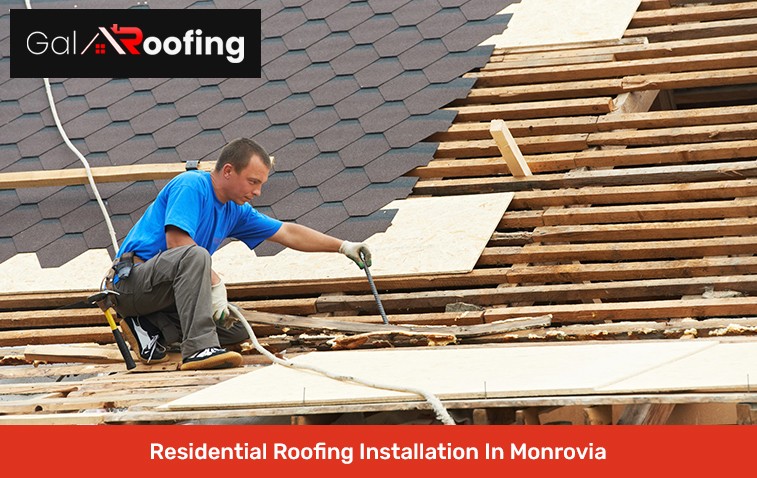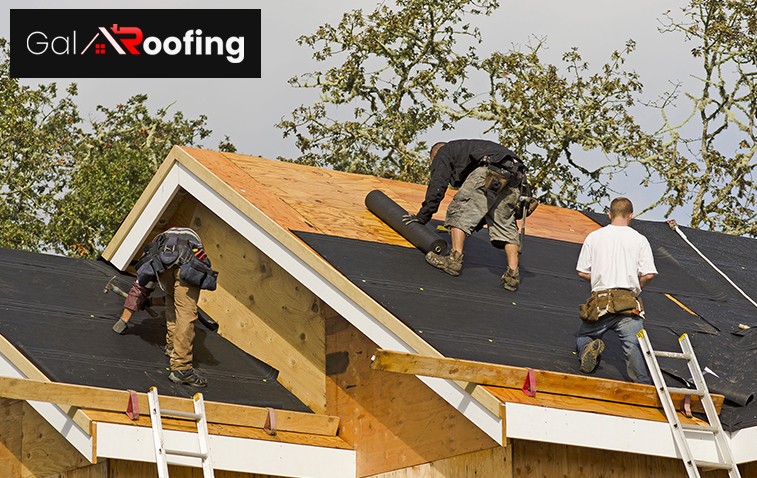Residential Roofing Installation in Monrovia
Residential roofing installation in Monrovia requires careful planning and execution to ensure that the roof is installed correctly and will last for years to come. The process involves various stages which include an initial inspection of the existing roof, removal of any old materials, installation of underlayment and flashing, and finally, installation of the new roofing material.

It’s important to obtain any necessary permits from the local building department to ensure compliance with building codes and regulations. Hiring a professional contractor for residential roofing installation in Monrovia is recommended to ensure the job is done right and to avoid potential safety hazards. At Gal Roofing, we have the knowledge, skills, and equipment necessary to complete the installation safely and efficiently, and to troubleshoot any issues that may arise during the process.
The Different Types of Roofing Materials that We Can Help You Install
Here are the different materials that you can choose from when it comes to residential roofing installation in Monrovia
Asphalt shingles
This is one of the most popular roofing materials due to its affordability and durability. Asphalt shingles are made from a fiberglass mat that is coated with asphalt and topped with granules.
Metal roofing
Metal roofing is another durable option that can last up to 50 years. It comes in a variety of materials, such as steel, aluminium, and copper, and can be installed in different styles, including standing seam, corrugated, and metal shingles.
Clay or concrete tiles
Clay and concrete tiles are popular in areas with Mediterranean or Spanish-style architecture. They are durable, energy-efficient, and come in a variety of colors and styles.
Slate
Slate is a natural stone that is known for its durability and longevity. It is fire-resistant, energy-efficient, and can last up to 100 years or more.
Wood shingles or shakes
Wood shingles or shakes are a traditional roofing material that can give a home a rustic look. They are made from cedar, redwood, or pine and can last up to 30 years with proper maintenance.
Synthetic roofing materials
Synthetic roofing materials, such as rubber or plastic, are becoming more popular due to their durability, energy efficiency, and affordability. They can mimic the look of traditional roofing materials while being more eco-friendly.
How to Choose the Right Material for Roofing Installation in Monrovia?
Choosing the right material for residential roofing installation in Monrovia can be a big decision, as your roof not only protects your home from the elements but also plays a crucial role in your home’s overall aesthetic appeal. Book a consultation, to know more. Here are some factors to consider before choosing the right roofing material in Monrovia

Climate
The climate in Monrovia can be hot and dry, with occasional heavy rain and strong winds. Therefore, it’s essential to choose a roofing material that can withstand these weather conditions
Style of Your Home
The style and architecture of your home will play a significant role in the choice of roofing material. For instance, a modern-style home may look better with a metal or flat roofing material, while a traditional-style home may look better with a slate or clay tile roofing material.
Durability
The durability of the roofing material is also an important factor to consider. Some materials, such as metal and concrete tiles, are known to be very durable, while others, such as asphalt shingles, have a shorter lifespan.
Cost
The cost of the roofing material and the installation can also be a significant factor in your decision. Some materials, such as asphalt shingles, are more affordable than others, such as slate or metal.
Here’s a table with some common residential roofing materials and their approximate costs per square foot (100 square feet).
| Roofing Material | Cost per square foot |
|---|---|
| Asphalt shingles | $1.50 – $5 |
| Metal | $4 – $12 |
| Wood shake | $6 – $9 |
| Slate | $10 – $30 |
| Concrete tile | $7 – $10 |
| Clay tile | $10 – $18 |
| Synthetic | $3 – $6 |
Maintenance
Different roofing materials require different levels of maintenance. For example, metal roofs are low maintenance, while wood shingles require regular maintenance to prevent rot and decay.
Energy Efficiency
Some roofing materials, such as metal roofs and cool roofs, can help reduce energy costs by reflecting sunlight and reducing heat absorption.
Local Building Codes
Before choosing a roofing material, make sure to check your local building codes and regulations to ensure that your chosen material meets the requirements.
Rules and Regulations for Residential Roofing
You need to follow the California Building Code and The Monrovia Municipal Code when you are planning for residential roofing installation in Monrovia
California Building Standards Code
Roofing Materials
The code specifies the types of roofing materials that are approved for use in California, including asphalt shingles, clay or concrete tiles, metal panels, and built-up roofs. The code also sets standards for the quality of these materials
Roofing Design
The code requires roofs to be designed to withstand the wind, rain, and seismic forces that are common in California. This includes requirements for roof slope, drainage, and fastening.
Underlayment
The code requires the use of an approved underlayment material between the roof covering and the roof deck to provide additional protection against moisture infiltration
Flashing
You should install approved flashing materials at all roof penetrations, including vents, chimneys, and skylights, to prevent water infiltration.
Ventilation
The building should have proper ventilation in the roof system to prevent moisture buildup and extend the life of the roof
Roofing Installation
The roofing materials should be installed according to the manufacturer’s specifications and industry standards. It also sets requirements for the installation of valleys, hips, ridges, and other roof details
Sections in Title 24 Related to Roofing Installation
Title 24 of the California Code of Regulations covers the California Building Standards Code. This code provides regulations and guidelines for building design, construction, and maintenance within the state of California. Within Title 24, there are sections that pertain to roofing installation.
Specifically, Section 1503.4 of the California Building Code (part of Title 24) outlines the requirements for roof covering installation. This section specifies that roof coverings must be installed in accordance with the manufacturer’s instructions and industry standards. It also outlines requirements for roof slope, underlayment, flashing, and other components of the roof system.
In addition, Section 1507 of the California Building Code covers requirements for roof assemblies. This section specifies the types of materials that can be used for roofing, such as asphalt shingles, tile, metal, and built-up roofing. It also outlines requirements for roof insulation, ventilation, and fire resistance.